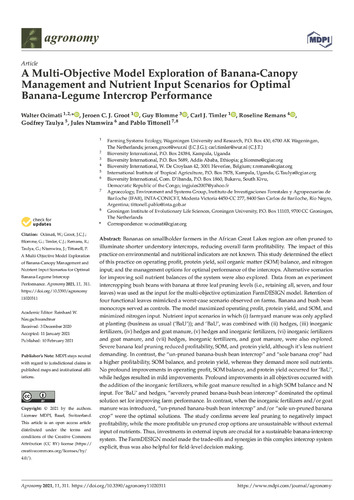A multi-objective model exploration of banana-canopy management and nutrient input scenarios for optimal banana-legume intercrop performance
Bananas on smallholder farmers in the African Great Lakes region are often pruned to illuminate shorter understory intercrops, reducing overall farm profitability. The impact of this practice on environmental and nutritional indicators are not known. This study determined the effect of this practice on operating profit, protein yield, soil organic matter (SOM) balance, and nitrogen input; and the management options for optimal performance of the intercrops. Alternative scenarios for improving soil nutrient balances of the system were also explored. Data from an experiment intercropping bush beans with banana at three leaf pruning levels (i.e., retaining all, seven, and four leaves) was used as the input for the multi-objective optimization FarmDESIGN model. Retention of four functional leaves mimicked a worst-case scenario observed on farms. Banana and bush bean monocrops served as controls. The model maximized operating profit, protein yield, and SOM, and minimized nitrogen input. Nutrient input scenarios in which (i) farmyard manure was only applied at planting (business as usual (‘BaU’)); and ‘BaU’, was combined with (ii) hedges, (iii) inorganic fertilizers, (iv) hedges and goat manure, (v) hedges and inorganic fertilizers, (vi) inorganic fertilizers and goat manure, and (vii) hedges, inorganic fertilizers, and goat manure, were also explored. Severe banana leaf pruning reduced profitability, SOM, and protein yield, although it’s less nutrient demanding. In contrast, the “un-pruned banana-bush bean intercrop” and “sole banana crop” had a higher profitability, SOM balance, and protein yield, whereas they demand more soil nutrients. No profound improvements in operating profit, SOM balance, and protein yield occurred for ‘BaU’, while hedges resulted in mild improvements. Profound improvements in all objectives occurred with the addition of the inorganic fertilizers, while goat manure resulted in a high SOM balance and N input. For ‘BaU’ and hedges, “severely pruned banana-bush bean intercrop” dominated the optimal solution set for improving farm performance. In contrast, when the inorganic fertilizers and/or goat manure was introduced, “un-pruned banana-bush bean intercrop” and/or “sole un-pruned banana crop” were the optimal solutions. The study confirms severe leaf pruning to negatively impact profitability, while the more profitable un-pruned crop options are unsustainable without external input of nutrients. Thus, investments in external inputs are crucial for a sustainable banana-intercrop system. The FarmDESIGN model made the trade-offs and synergies in this complex intercrop system explicit, thus was also helpful for field-level decision making.

